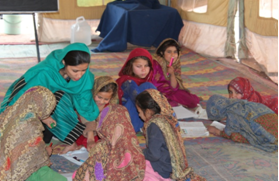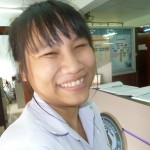This commentary is titled “The Heart of the Matter”, this is the name of a famous song made popular by Don Henley, of the Eagles. As so often happens, the melodies of music and the lyrics of songs truly speak to us. What I will focus here, is matter about education, but what I am about to say also brings to my mind the title of that beautiful love song sung so well by Don Henley and many others. Although the song’s theme is different from our mission and this article, its title is truly relevant to the cause of this web site.
The SCLThailand website is dedicated to assisting Thai school administrators and classroom teachers to move more swiftly than has been possibly so far, towards the realization of the goal of student centred learning being the norm in Thai government schools. This goal was established in the Thai National Education Act, 1999 (Buddhist Era, 2542). Interestingly, the Act did not set a date for the massive paradigm shift that it seeks to happen.
Would it have been better to set a date for national implementation of that important goal? That is a question with many pros and cons.
Let us get back to “The Heart of the Matter”. It is now March 2012 [BE 2555], 13 years have passed since the promulgation of the Act. I wrote in a previous article [January 2012] about the need for education reformers to recognise that change is a slow process, this is certainly being borne out by the slow pace of change in implementing the move to student centred learning in Thailand.
Perhaps a symptom or sign of the lack of progress is the entrenched nature of the examination system in Thai schools. Each year, in mid March, students are very busy studying for end of year exams. On the face of it, this seems quite reasonable, but a few questions come up. Exactly which students are preparing for exams? Answer: From primary school students as young as 6 years old in Primary 1 [Prathom 1] up to Year 12 in secondary [Matayom 6].
This leads to further questions. How do young students in Year 1 prepare themselves for these examinations? What is the general content of the examinations? Another significant question to ask is – why is it that children as young as this are subjected to examinations at all? Another important question is – what hangs on the outcomes of the examinations?
I ask these questions in the hope that they will provoke some discussion on this website. The emphasis on examinations runs counter to the way students’ progress would be assessed in a pedagogical system where the student is at the centre of the teaching and learning.
In a student centered system there would be little emphasis on examinations – this may even be true for Thai schools today – the exam is not so important, although I suspect that is not the case.
But what about “The Heart of the Matter”?
Let me come to it quite pointedly, “The Heart of the Matter” in educational terms is this: at the very core of the classroom, the school, the education system, and the nation’s standing in international educational performance rankings, it is the teacher who matters most in students’ learning achievement. There is plenty of research evidence about this. However, this is not the place to quote much of the research evidence. Perhaps the best evidence of the key role of the teacher is to look at the highest performing education systems in Asia and examine the factors which make them such high performing systems.
Four of the world’s highest performing education systems are from Asia. These are Hong Kong, Korea, Shanghai, and Singapore. The OECD’S Performance Indicators of Student Achievement [PISA] assessments in 2009 showed for example, that in Mathematics, 15 year old students from Shanghai performed two or three years above the level of students of the same age in Australia, the USA.
What is it about these four education systems that puts them well above other Asian systems and puts them in the class of world top performers?
The Grattan Institute from Melbourne University in Australia examined the four systems in an endeavour to get an answer to this question. The results of their investigation were published in an important report – Catching Up: Learning from the best school systems in East Asia [http://www.grattan.edu.au]
What the Institute found:
There is growing global agreement on what works in schools
A body of international research has identified the common characteristics of high-performing education systems.
They:
• Pay attention to what works and what doesn’t. They attend to best practice internationally, give close attention to measuring success, and understand the state and needs of their system.
• Value teachers and understand their profession to be complex. They attract high quality candidates, turn them into effective instructors and build a career structure that rewards good teaching.
• Focus on learning and on building teacher capacity to provide it. Teachers are educated to diagnose the style and progress of a child’s learning. Mentoring, classroom observation and constructive feedback creates more professional, collaborative teachers.
The four high performing East Asian systems are implementing what works. They have introduced one or several of the following reforms.
In particular they:
• Provide high quality initial teacher education. In Singapore, students are paid civil servants during their initial teacher education. In Korea, government evaluations have bite and can close down ineffective teacher education courses.
• Provide mentoring that continually improves learning and teaching. In Shanghai, all teachers have mentors, and new teachers have several mentors who observe and give feedback on their classes.
• View teachers as researchers. In Shanghai teachers belong to research groups that continuously develop and evaluate innovative teaching. They cannot rise to advanced teacher status without having a published paper peer reviewed.
• Use classroom observation. Teachers regularly observe each other’s classes, providing instant feedback to improve each student’s learning.
• Promote effective teachers and give them more responsibility for learning and teaching. Master Teachers are responsible for improving teaching throughout the system.
A few of the keys they took: In Hong Kong the emphasis on examinations was abandoned, in Singapore teacher education courses were re developed so they place a much greater emphasis on practical classroom management and pedagogical methodology accompanied by a reduction in the philosophical and reflective elements of the courses. In Singapore, pre service teachers are paid as government employees. In Shanghai teacher’s class contact hours were reduced so they would have more time to work with mentor teachers.
But the key thing is that in each of these systems government education policy is always linked closely with teachers’ working conditions, professional learning and career pathways.
In future months we will explore these systems more deeply.
I wonder how many of the reforms evident in Singapore Hong Kong Korea and Shanghai, have been considered in Thailand?
Whichever way educational reform is looked at, researched and examined, at the heart of educational improvement, are the teachers. In his book, Why Not the Best Schools? [ACER Press, Camberwell, Australia, 2008] Brian Caldwell devotes a chapter to demonstrate that the quality of schools will never exceed the quality of the staff.
It is in this area, that Thailand needs to make some giant leaps so that its teachers will be trained and supported in such a way that will help the country achieve the goals of the National Education Act of 1999. The Thai system can be as good the four Asian high flyers mentioned here, but my guess is that it needs to look closely at what those systems have done to move educational reform so quickly. Similar things could be done in Thailand.
Greg Cairnduff
Acting Editorหัวใจสำคัญ
12 มีนาคม 2555
บทวิจารณ์นี้ตั้งชื่อว่า “หัวใจสำคัญ” คือชื่อของบทเพลงอันโด่งดังจากฝีมือของดอน เฮนลีย์ แห่งวง ดิ อีเกิ้ล และอย่างที่มักเกิดขึ้นเสมอ เนื้อร้องและทำนองของเพลงนี้พูดถึงพวกเราจริงๆ สิ่งที่ผู้เขียนจะมุ่งประเด็นไปในที่นี้ คือเรื่องเกี่ยวกับการศึกษา แต่สิ่งที่ผู้เขียนกำลังจะกล่าวถึงนั้นได้พาให้ผู้เขียนนึกไปถึงชื่อเพลงของบทเพลงรักที่งดงามซึ่งถูกขับร้องไว้อย่างไพเราะโดยดอน เฮนลีย์และนักร้องท่านอื่นๆ แม้ว่าเนื้อหาหลักของบทเพลงจะแตกต่างจากงานของเราและบทความนี้ ชื่อเพลงนี้กลับเกี่ยวข้องกับเหตุผลการมีอยู่ของเว็บไซท์นี้อย่างแท้จริง
เว็บไซท์ SCL ประเทศไทยสร้างขึ้นเพื่อเป็นการช่วยเหลือผู้บริหารและอาจารย์ผู้สอนในโรงเรียนในประเทศไทยให้เดินหน้าเกิดความเคลื่อนไหวมากขึ้นกว่าที่เป็นอยู่ในปัจจุบัน สู่การตระหนักถึงการให้การเรียนรู้โดยมีนักเรียนเป็นศูนย์กลางเป็นบรรทัดฐานของการเรียนรู้ในโรงเรียนของประเทศไทย จุดมุ่งหมายนี้ถูกบัญญัติไว้ในพระราบัญญัติการศึกษาแห่งชาติ พ.ศ. 2542 ซึ่งเป็นที่น่าสังเกตว่าพรบ.นี้ไม่ได้กำหนดวันที่เอาไว้สำหรับการปรับเปลี่ยนกระบวนทัศน์ครั้งใหญ่นี้
น่าจะดีกว่าไหมหากจะมีการกำหนดวันเอาไว้ให้เป็นที่รับรู้ทั่วกันสำหรับเป้าหมายสำคัญเช่นนี้? นั่นเป็นคำถามที่มีทั้งผู้คัดค้านและสนับสนุน
กลับเข้ามาสู่ “หัวใจสำคัญของเรื่อง” ของเรา ตอนนี้คือเดือนมีนาคม 2555 สิบสามปีให้หลังนับจากพระราชบัญญัติประกาศใช้ ผู้เขียนเขียนไว้ในบทความก่อนหน้า (มกราคม 2555) เกี่ยวกับความจำเป็นสำหรับนักปฏิรูปการศึกษาที่จะตระหนักว่าการเปลี่ยนแปลงนี้เป็นไปอย่างช้าๆ นี่ย่อมเป็นผลเนื่องมาจากความเชื่องช้าของกระบวนการเปลี่ยนแปลงในการดำเนินการสร้างการเรียนรู้โดยนักเรียนเป็นศูนย์กลางในประเทศไทย
บางที สัญญาณหรือข้อบ่งชี้ถึงความไม่คืบหน้านี้คือการยึดติดอยู่กับระบบการสอบในโรงเรียนในประเทศไทย แต่ละปี เด็กนักเรียนจะง่วนอยู่กับการสอบปลายภาคการศึกษา มองเผินๆแล้วนี่ก็เป็นเรื่องที่สมเหตุสมผล แต่มีคำถามบางข้อขึ้นมาว่า จริงๆแล้วเด็กนักเรียนคนไหนบ้างที่ต้องเตรียมตัวเพื่อการสอบ? คำตอบคือ: นับตั้งแต่นักเรียนชั้นประถมศึกษาปีที่ 1 ไปจนถึงนักเรียนชั้นมัธยม 6
สิ่งนี้นำไปสู่คำถามถัดไป เด็กประถมหนึ่งจะเตรียมตัวในการสอบอย่างไร? เนื้อหาที่ออกสอบมีอะไรบ้าง? อีกหนึ่งคำถามสำคัญคือ – ทำไมถึงต้องมีการสอบสำหรับเด็กที่เล็กขนาดนั้นด้วย? อีกหนึ่งข้อที่สำคัญคือ – สอบแล้วได้อะไร?
ผู้เขียนถามคำถามเหล่านี้ด้วยความหวังว่ามันจะกระตุ้นให้เกิดการแสดงความคิดเห็นขึ้นในที่แห่งนี้ การให้ความสำคัญกับการสอบวัดผลขัดแย้งกับวิถีทางประเมินความก้าวหน้าของนักเรียนในระบบการศึกษาที่นักเรียนเป็นศูนย์กลางของการเรียนและการสอน
ในการศึกษาแบบผู้เรียนเป็นศูนย์กลางจะให้ความสำคัญเพียงเล็กน้อยกับการประเมินผล – นี่อาจเป็นเรื่องจริงสำหรับโรงเรียนในประเทศไทยทุกวันนี้- การสอบไม่สำคัญนัก แม้ว่าผู้เขียนจะกังขาว่ามันไม่ใช่อย่างนั้นก็ตาม
แล้ว “หัวใจสำคัญ” ล่ะ?
จะให้กล่าวอย่างตรงไปตรงมาแล้ว ”หัวใจสำคัญ” ในทางการศึกษานั้นคือ : ในใจกลางของชั้นเรียน, โรงเรียน, ระบบการศึกษา.และการจัดอันดับผลการดำเนินการทางการศึกษาของประเทศในระดับนานาชาติ ก็คือครูซึ่งเป็นผู้ที่มีผลมากที่สุดต่อผลสัมฤทธิ์ทางการเรียนของนักเรียน มีงานวิจัยมากมายเป็นข้อสนับสนุนเกี่ยวกับประเด็นนี้ อย่างไรก็ตาม นี่ไม่ใช่ที่ที่เราจะมาพูดกันถึงหลักฐานทางการวิจัย บางทีหลักฐานที่ดีที่สุดของบทบาทสำคัญของครูอาจเป็นการศึกษาจากระบบการศึกษาที่มีประสิทธิภาพสูงสุดของเอเชียและมาสำรวจถึงปัจจัยที่ทำให้เกิดผลเช่นนั้น
สี่ประเทศที่มีระบบการศึกษาดีที่สุดในโลกในทวีปเอเชีย ได้แก่ฮ่องกง, เกาหลี. เซี่ยงไฮ้ และสิงคโปร์ หลักสูตรการประเมินผลนักเรียนนานาชาติ(PISA) ขององค์การเพื่อความร่วมมือทางเศรษฐกิจและการพัฒนา (OECD) ปี 2552 ได้ยกตัวอย่างให้เห็น เช่นในวิชาคณิตศาสตร์ เด็กนักเรียนอายุ 15 ปีของเซี่ยงไอ้ มีความสามารถสูงกว่าเด็กนักเรียนที่อายุเท่ากันในออสเตรเลียหรืออเมริกาไปสองถึงสามปี
อะไรคือสิ่งที่ทำให้ระบบการศึกษาในสี่ประเทศเหล่านี้มีความก้าวหน้าเหนือกว่าระบบของประเทศอื่นๆในเอเชีย และทำให้ประเทศเหล่านั้นก้าวขึ้นไปอยู่ในระดับแนวหน้าของโลก
สถาบันกราทตันจากมหาวิทยาลัยเมลเบิร์นในออสเตรเลียพยายามทำการศึกษาระบบทั้งสี่นี้เพื่อค้นหาคำตอบ พวกเขานำเสนอผลการค้นคว้านี้ในรายงานสำคัญ – ตามให้ทัน: เรียนรู้จากระบบโรงเรียนที่ดีที่สุดของเอเชียตะวันออก [http:www.grattan.edu.au]
สิ่งที่สถาบันค้นพบ:
คนทั่วโลกเห็นด้วยเพิ่มขึ้นว่าอะไรที่เหมาะสมกับโรงเรียน
เนื้อหาของการวิจัยแสดงให้เห็นถึงข้อพื้นฐานของระบบการศึกษาขั้นสูง
ระบบนั้น:
– ให้ความสำคัญว่าอะไรได้ผลและอะไรไม่ได้ผล พวกเขาเข้าร่วมการฝึกฝนในระดับสากล ให้ความเอาใจใส่อย่างใกล้ชิดกับวิธีการวัดผลความสำเร็จ, และเข้าในสภาพและความต้องการของตนเอง
– เห็นคุณค่าของครูและเข้าใจว่าอาชีพนี้มีความซับซ้อน ให้ข้อจูงใจผู้สมัครที่มีคุณภาพสูง ให้เขาเหล่านั้นทำหน้าที่เป็นผู้ฝึกสอนที่มีประสิทธิภาพและสร้างโครงสร้างรายได้อาชีพที่ตอบสนองกับการสอนที่ดี
– ให้ความสำคัญกับการเรียนรู้และการพัฒนาศักยภาพของครูให้ตอบสนองต่อการเรียนรู้นั้น ครูจะได้รับความรู้เพื่อจะเข้าใจลักษณะและกระบวนการของการเรียนรู้ของเด็ก, การให้คำปรึกษา, การสังเกตชั้นเรียน และคำแนะนำที่สร้างสรรค์ก็จะสร้างครูที่มีความเชี่ยวชาญมากยิ่งขึ้น
สิ่งที่ทั้งสี่ระบบการศึกษาชั้นนำของเอเชียตะวันออกใช้ได้ผล ได้แนะนำหนึ่งหรือหลายข้อต่อไปนี้
โดยทั่วไป โรงเรียนเหล่านั้น:
– จัดการอบรมวิชาชีพครูที่มีคุณภาพ ในสิงคโปร์ นักศึกษาจะได้รับเงินเดือนในระหว่างที่อบรม ในประเทศเกาหลีการประเมินของรัฐบาลสามารถสั่งปิดหลักสูตรการอบรมครูที่ไม่มีประสิทธิภาพได้
– มีที่ปรึกษาเพื่อการพัฒนาการเรียนรู้และการสอนอย่างต่อเนื่อง ในเซี่ยงไฮ้ ครูทุกคนจะมีที่ปรึกษา และครูจบใหม่จะมีที่ปรึกษามากกว่าหนึ่งคนที่จะคอยดูแลและให้ความเห็นในการสอนของครูจบใหม่
– มองครูในฐานะนักวิจัย ในเซี่ยงไฮ้ครูเป็นส่วนหนึ่งของคณะวิจัยเพื่อการพัฒนาและประเมินวิธีการสอนใหม่ๆอย่างต่อเนื่อง ครูไม่สามารถเพิ่มวิทยฐานะของตนเองได้หากปราศจากการพิมพ์เผยแพร่ผลงาน
– ใช้การเยี่ยมชมห้องเรียน ครูทุกคนจะไปเยี่ยมชมชั้นเรียนอื่นเป็นประจำ ให้ข้อคิดเห็นที่จะช่วยในการพัฒนาการเรียนรู้ของนักเรียนในชั้นเรียนของแต่ละคน
– เลื่อนตำแหน่งให้แก่ครูที่มีคามสามารถและมอบหมายหน้าที่รับผิดชอบมากกว่าเดิมในการเรียนและการสอน หัวหน้าครูจะรับผิดชอบส่วนงานพัฒนาการสอนทั้งระบบ
หลักสำคัญที่โรงเรียนเหล่านั้นใช้: ในฮ่องกง ความสำคัญของการสอบถูกมองข้าม ในสิงคโปร์ หลักสูตรการเรียนของครูถูกปรับปรุงใหม่โดยให้ความสำคัญมากขึ้นกับการฝึกสอนการจัดการชั้นเรียนจริงและวิธีการสอนในพร้อมกัน โดยการลดลงในส่วนปรัชญาและหัวข้ออื่นที่เกี่ยวข้องในหลักสูตร ที่สิงคโปร์ ครูฝึกสอนจะได้รับเงินเดือนเทียบเท่าเจ้าหน้าที่ของรัฐ และที่เซี่ยงไฮ้มีการลดชั่วโมงการสอนของครูลงเพื่อให้พวกเขามีเวลาทำงานกับที่ปรึกษาครูมากขึ้น
แต่สิ่งสำคัญคือ ในแต่ละระบบเหล่านี้ นโยบายด้านการศึกษาของรัฐบาลจะเชื่อมโยงอย่างใกล้ชิดกับเงื่อนไขการทำงานของครู, การเรียนรู้อย่างผู้เชี่ยวชาญและเส้นทางอาชีพ
ในโอกาสหน้าเราจะศึกษาระบบการศึกษาเหล่านี้ให้ลึกซึ้งยิ่งขึ้น
ผู้เขียนนึกสงสัยว่านักปฏิรูปในสิงคโปร์, ฮ่องกง, เกาหลีและเซี่ยงไฮ้ เคยนึกถึงประเทศไทยบ้างหรือไม่?
วิธีใดก็ตามที่ โยการวิจัยและการทดสอบ หัวใจหลักสำคัญของการพัฒนาระบบการศึกษาคือตัวอาจารย์ ในหนังสือ ทำไมถึงไม่เอาโรงเรียนที่ดีที่สุด? [ACER Press, Camberwell, ออสเตรเลีย, 2008] ของไบรอัน คาดเวล เขาได้เขียนไว้ในบทหนึ่งเพื่อแสดงว่าคุณภาพของโรงเรียนไม่มีทางเกินไปกว่าคุณภาพของครูในโรงเรียน
มันก็คือในที่นี้ ประเทศไทยต้องมีการก้าวกระโดดเพื่อให้ครูในประเทศมีการฝึกฝนและได้รับการสนับสนุนในทางที่จะช่วยให้ประเทศบรรลุถึงเป้าหมายของพระราชบัญญัติการศึกษาแห่งชาติ พ.ศ. 2542 ระบบการศึกษาของไทยสามารถก้าวหน้าได้เทียบเท่าระบบการศึกษาของสี่ประเทศในเอเชียที่ได้กล่าวถึงไว้ในบทความนี้ แต่ในความคิดของผู้เขียนเราต้องมองดูอย่างลึกซึ้งว่าประเทศเหล่านั้นทำอย่างไรจึงทำให้การปฏิรูปการศึกษาพัฒนาไปอย่างรวดเร็ว สิ่งนั้นน่าจะกระทำได้เช่นกันในประเทศไทย
Greg Cairnduff
รักษาการณ์บรรณาธิการ
 This photograph, sent from Pakistan by our Managing Editor, Dr Peter Foley, shows the active involvement of the teacher and the engagement of the students in a school which is not much more than a tent. Please make sure you read the article on the “Caring School”.
This photograph, sent from Pakistan by our Managing Editor, Dr Peter Foley, shows the active involvement of the teacher and the engagement of the students in a school which is not much more than a tent. Please make sure you read the article on the “Caring School”.




